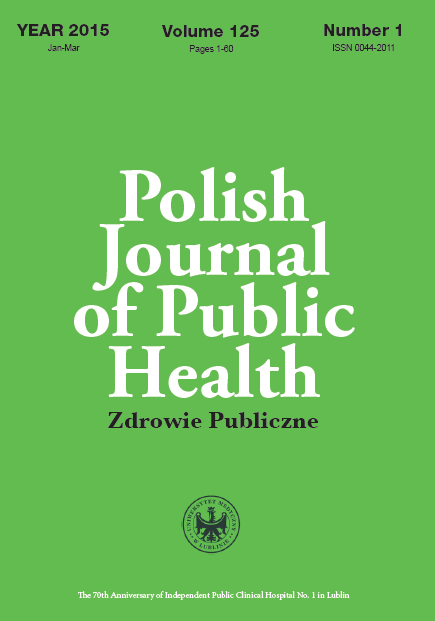The cooperation between orthodontists and surgeons in treating facial skeletal deformities
DOI:
https://doi.org/10.1515/pjph-2015-0023Keywords:
skeletal deformities, orthodontic treatment, surgical treatmentAbstract
Face skeletal deformities have been confusing both doctors and patients for ages. The harmony of the face exerts huge influence not only on one’s psyche but also the behavior and the individual’s social and professional status. In this study we present a procedure of treating skeletal malocclusion. It was performed using various orthodontic methods, like the alteration of the growth of jaws and camouflage applied in appropriate age groups. We paid special attention to the close cooperation between the orthodontist and the surgeon, which hugely facilitates curing the most complex, multi-dimensional deformities.
In this study, we present our own materials concerning the effects of cooperation between two departments of Medical University of Lublin, namely the Chair and Clinic of Maxillofacial Surgery and Department of Jaw Orthopedics.
References
1. Dion K, Berscheid E, Walster E. What is beautiful is good. J Pers Soc Psychol. 1972;24:285-90. [PubMed][CrossRef]
2. Langlois JH, Kalakanis L, Rubenstein AJ, et al. Maxims or myths of beauty.A meta-analytic andtheoretical review. Psychol Bull. 2000;126:350-423.
3. Senior C, Thomson K, Badger J, Butler MJ. Interviewing strategies in the face of beauty. A psychophysiological investigation into the job navigation process. Ann N Y Acod Sci. 2007;1118:142-62. [Web of Science]
4. Langlois JH, Ritter JM, Casey RJ, et al. Infant attractiveness predicts maternal behaviors and attitudes. Dev Psychol. 1995;31:464-72. [CrossRef]
5. Ritter JM, Casey RJ, Langlois JH. Adults responses to infantis varying in appearance of age and attractiveness. Child Dev. 1991;62:68-82.
6. Choi WS, Lee S, McGrath C, Samman N. Change in quality of life after combined orthodontic-surgical treatment of dentofacial deformities. Oral Surg Oral Med. 2010;109:46-51.
7. Johnston C, Hunt O. Burden D, et al. Self-pereption of dentofacial attractvensess among patients requiring orthognathic surgery. Angle Orthod. 2010;80:361-6. [CrossRef] [Web of Science]
8. Takada K, Petdachai S, Sakaduda M. Changes in dentofacial morphology in skeletal Class III children treated by a modified maxillary protraction headgear and a chin cup: a longitudinal cephalometric appraisal. Eur J Orthod. 1993;15:211-21.
9. Freeman CS, Mc Namara JA Jr, Bacetti T, et al. Treatment effects of the bionator and high-pull facebow combination followed by fixed appliances in patients with increased vertical demensions Am J Orthod Dentofacial Orthop. 2007;131:184-95. [Web of Science]
10. Tulloch JF, Phillipes C, Koch G, Proffit WR. The effect of early intervention on skeletal pattern in Class II malocclusion: a randomized clinical trial. Am J Orthod Dentofac Orthop.1997;111:391-400.
11. Proffit WR, White RP, Sarver DM. Contemporary treatment of dentofacial deformity. St. Louis: Mosby; 2003.
12. Lines PA, Steinhauser EW. Soft tisssue changes in relationship to movement of hard structures in orthognatic surgery: a preliminary report. J Oral Surg. 1974;32:891-6.
13. Wolford LM, Hilliard FW. The surgical-orthodontic correction of vertical dentofacial deformities. J Oral Surg. 1981;39:883-97.
14. Dal Pont G. Retromolar osteotomy for correction of prognathism. J Oral Surg. 1961;19:42-7.
15. Epker BN. Modifications in the sagittal split osteotomy of the mandible. J Oral Surg. 1977;35:157-62 .
16. Gruber RM, Kramer FJ, Merten HA, Schliephake H. Ultrasonic surgeryan alternative way in orthognathic surgery of the mandible. A pilot study. Int J Oral Maxillofac Surg. 2005;34:590-3.
17. Tomaszewski T, Dobieżyńska B. Piezosurgery-alternative new way in orthognatic surgery. Pol J Environ Stud. 2007;16:379-81.
Downloads
Published
Issue
Section
License
Copyright (c) 2015 Polish Journal of Public Health

This work is licensed under a Creative Commons Attribution-NonCommercial-NoDerivatives 3.0 Unported License.


